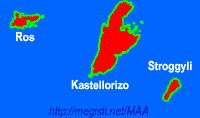Cube Art
Share
(Click to Enlarge)
Cube Art was one of the 72 entries in last year's IPP Design Competition. Unfortunately, it didn't win an award, as it faced some tough contestants, but it doesn't mean that it's less interesting.
Inspired by the work of Dutch painter Piet Mondrian, Durandus Dijken from The Netherlands, invented and designed the Cube Art. It comes in a nice plastic container cube with a sliding lid and it sort of reminds me of the Pattern Puzzle Instant Insanity, where you had to arrange four cubes in a row, so that it showed four different colors on each side.
In the Cube Art, the goal is similar: you have eight blocks divided in three categories: a 1x1x1 cube, a 2x2x2 cube, three 1x1x2 and three 2x2x1 blocks, and they can have a combination of six colors, although some blocks won't feature all six different colors on them. Instead, they can have a repeated color, which adds to a much higher level of difficulty. By choosing a four different color combination, you have to assemble the blocks into a cube and repeat that combination on each of the cube's six faces.
To maintain the blocks into a cube form without falling apart, the designer implemented magnets on each piece and a magnetic plate between the two layers. This way, it becomes much easier to assemble the cube.
(Click to Enlarge)
At first, your task is simplified at choosing the right color combination, because you are given the three known solutions. You can see three small pictures in a sticker, found at one of the magnetic plate's sides, showing which colors are part of each of the three solutions. Solution 1 has white, yellow, red and blue; solution 2 has orange, red, green and blue and solution 3 has white, yellow, orange and green.
Don't think that because you know which colors to use, that the puzzle is halfway solved. When you receive the puzzle, it already comes solved with one solution, to better give you an understanding of how it works. It took me about two hours to find the first solution, or second, if you count the one it came solved, although a while after you take it apart, you don't remember anymore, how the blocks were organized. There were many times when I had only one block left to place, but it resulted in disappointment and frustration every time, until finally in a surprising moment, I had solved it. Not easy, at all...
(Click to Enlarge) - Solution 2
Finding the last solution, however, it was much faster for me. It only took me about half an hour. Not sure if it was a stroke of genius or just pure luck, though, but the important thing is that I solved it. Now, all I need is just to find the correct block placement for the first solution, the one that the puzzle came in... Or is it? - I wish it were that simple...
(Click to Enlarge) - Solution 3
One of the coolest things about the puzzle is that, after you solve the three known color configurations, you have a much harder challenge in your hands, which is to find a fourth secret solution. This time, you don't have any information regarding the colors you're supposed to use, you're simply on your own. I still haven't found this solution yet.
The fourth solution was found by the designer himself, after the puzzle had been published, by analyzing it in further detail. In theory, there could be 15 possible configurations with the six existing colors, but only four of them are solvable. Is it really possible to have more solutions? Now there's a nice challenge for a mathematician...
Closing Comments:
I enjoyed very much, playing with the Cube Art. Besides using magnets, which is always cool in a puzzle, I liked the challenge. It requires just the right amount of frustration from you, so that it never feels overcomplicated, and yet providing a satisfying rewarding feeling.
To buy your copy, you can visit the puzzle's website or contact Durandus Dijken directly.






































1 comments:
I've found 2 solves in addition to the original 3. One of them on the solve with the big block having red-white-yellow showing, by switching two pieces (the narrower edge opposite the yellow face and the tiny cube) around. The other a novel solve with yellow-orange-red showing on the big block. So I think there are at least 5 solves.
Post a Comment